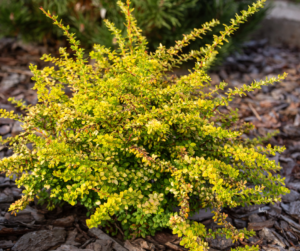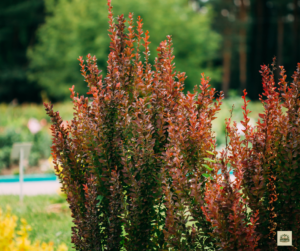Learn Barberry Identification Then Avoid Planting Them
Hey there eco-friendly homeowners! Do you ever feel like Japanese barberry is playing a game of hide and seek in your yard? Like it's just waiting to jump out and say "Surprise! I'm taking over!" Well, let me tell you, you're not alone. This little invader has been causing quite a stir in the plant world and it's time we unmask it for what it really is - a total landscape hog!
First things first, let's talk about what makes Japanese barberry such a sneaky little devil. It's got these small, oval-shaped leaves that cluster together like they're having a secret meeting. And don't even get me started on the thorns! They're sharp enough to make a porcupine jealous. Plus, they're often hiding beneath the foliage like they're playing a game of peek-a-boo.
Common Varieties (Still not recommended for the eco-system)
They are still selling barberry at nurseries. There are several improved varieties that look better and are not as big of menace. If barberry is not a big problem in your area and you need to plant barberry for deer control or other good reason, here are a few popular varieties. This guide should also help you identify barberry that looks a little different so you can eliminate it. I suggest avoid them if possible.


'Rose Glow' (Berberis thunbergii 'Rose Glow')
New leaves emerge as a striking rose pink mottled with deep purple and white. As the leaves mature, they turn a deep purplish-red. Rose Glow reaches about 4 to 5 feet in height and width. Upright and bushy, with arching branches. Notable for its variegated foliage with a marbled mix of pink, purple, and white, especially prominent on new growth. It produces small yellow flowers in spring, followed by bright red berries in fall
'Crimson Pygmy' (Berberis thunbergii 'Crimson Pygmy')
Deep crimson to burgundy-red leaves throughout the growing season, retaining color well into fall. Small, oval leaves with a slightly leathery feel. Compact dwarf variety growing about 2 to 3 feet tall and wide.
Its dwarf size and consistent deep red foliage make it ideal for borders, rock gardens, and low hedges. May produce tiny yellow flowers and occasional red berries, though less prolific than larger varieties.
'Golden Nugget' (Berberis thunbergii 'Golden Nugget')
Vibrant golden-yellow leaves that can turn orange or red in the fall. Small and fine-textured, adding a delicate appearance. Very small, typically reaching only about 1 foot tall and wide. Dwarf and compact, with a slow growth rate. Among the smallest barberry varieties, making it perfect for rock gardens or edging. Its bright golden foliage adds a splash of color to the landscape, especially when contrasted with darker plants.
'Helmond Pillar' (Berberis thunbergii 'Helmond Pillar')
Deep purple to burgundy leaves that may turn brighter red in the fall. Smooth leaves aligned closely along upright stems. Grows 4 to 5 feet tall but stays narrow, only about 1 to 2 feet wide. Columnar and upright, resembling a pillar.
Unique vertical growth makes it stand out among other barberries, suitable for tight spaces or as an architectural element. Ideal for adding height without taking up much horizontal space.
'Aurea' (Berberis thunbergii 'Aurea')
Bright yellow to chartreuse leaves that can develop a slight reddish tint in full sun or in the fall. Soft, with a velvety feel. Typically grows 3 to 4 feet tall and wide. Rounded and slightly spreading, with dense branching.
The luminous yellow foliage illuminates garden spaces, especially effective in shaded areas where the color brightens darker corners. More tolerant of shade than other golden varieties, though color is best in full sun.
How to Tell Them Apart By Foliage Color and Pattern
'Rose Glow': Look for the distinctive marbled pink, purple, and white variegation on new growth.
'Crimson Pygmy': Identified by its consistent deep crimson-red foliage.
'Golden Nugget': Notable for its bright golden-yellow leaves.
'Helmond Pillar': Deep purple leaves similar to 'Crimson Pygmy' but differs in growth habit.
'Aurea': Bright yellow to chartreuse foliage, which may gain a reddish hue.
Several states, including Massachusetts, Minnesota, Wisconsin, and others, have restrictions or bans on the sale and planting of Japanese barberry. Do not trust big box stores to know what plants are on the invasive lists. They commonly sell plants that are not ideal for their area and are discouraged.
By understanding the key characteristics of these popular Japanese barberry varieties, you can select the right one for your garden and recognize them in the landscape.
Why Barberry is Bad
But here's the real kicker - Japanese barberry is like the ultimate party crasher. It can thrive in all sorts of conditions, from shady forests to sunny fields. It's like it has a VIP pass to every habitat in town! And once it gets settled in, it starts reproducing like crazy. We're talking up to 10,000 seeds per plant! That's enough offspring to start a small army.
Now, I know what you're thinking - "But it's just a little shrub. How bad can it really be?" Well, let me tell you, this little shrub is like the Godzilla of the plant world. It can completely take over an area, choking out all the native plants and leaving behind a barren wasteland. It's like it's on a mission to create its own botanical monopoly!
But wait, there's more! Not only is Japanese barberry a total bully to other plants, it's also a magnet for ticks. I'm talking up to 12 times more ticks than in areas without barberry. And we all know what ticks mean - Lyme disease. It's like Japanese barberry is running a tick Airbnb in your backyard!
Eliminating Barberry
So, what can we do about this spiky menace? Well, my eco-friendly friends, it's time to put on our gardening gloves and get to work. The first step is to identify the enemy. Look for those telltale oval leaves, red berries, and sneaky thorns. And don't be fooled by its charming yellow flowers in the spring - that's just a distraction tactic!
Once you've spotted the intruder, it's time to take action. You can go the mechanical route and pull those suckers out by hand (just watch out for the thorns!). Or, you can bring in the big guns and use some herbicides. But be careful - you don't want to accidentally take out any innocent bystanders in the process.
And here's a fun fact for all you electric mower enthusiasts out there - proper maintenance can actually help reduce the spread of Japanese barberry! By keeping your mower blades sharp and clean, you'll be less likely to accidentally spread those pesky seeds around. Plus, you'll be doing your part to reduce your carbon footprint. It's a win-win!
But let's not forget the real MVP in the fight against Japanese barberry - Mother Nature herself. By introducing some natural predators or pathogens that specifically target barberry, we can let nature do the heavy lifting for us. It's like calling in the plant police to take care of business!
At the end of the day, the key to beating Japanese barberry is persistence. It's not going to go down without a fight, but with a little elbow grease and a lot of determination, we can reclaim our yards and restore some balance to the ecosystem. And who knows - maybe we can even have a little fun in the process! Just think of it as a real-life game of Plants vs. Zombies, except instead of zombies, we're fighting off a horde of spiky shrubs.
Conclusion
So, my fellow eco-warriors, let's gear up and show Japanese barberry who's boss. With the right tools, the right attitude, and a healthy dose of humor, we can take back our landscapes and create a greener, healthier world for all. And if all else fails, just remember - when life gives you barberries, make barberry jam! (Just kidding, please don't eat the barberries. They're not that kind of berry.)
